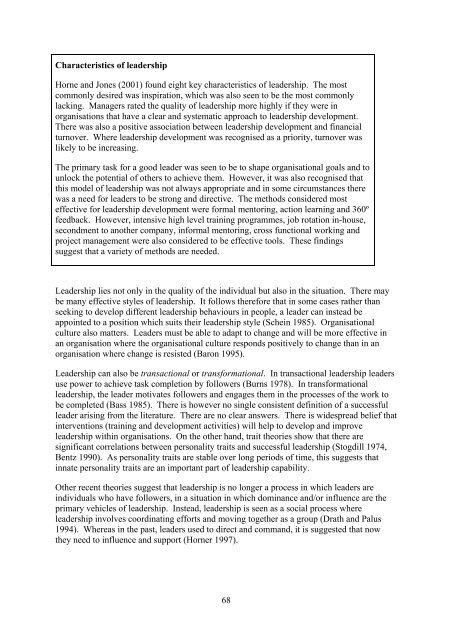The Development of Management and Leadership Capability and its ...
The Development of Management and Leadership Capability and its ...
The Development of Management and Leadership Capability and its ...
You also want an ePaper? Increase the reach of your titles
YUMPU automatically turns print PDFs into web optimized ePapers that Google loves.
Characteristics <strong>of</strong> leadership<br />
Horne <strong>and</strong> Jones (2001) found eight key characteristics <strong>of</strong> leadership. <strong>The</strong> most<br />
commonly desired was inspiration, which was also seen to be the most commonly<br />
lacking. Managers rated the quality <strong>of</strong> leadership more highly if they were in<br />
organisations that have a clear <strong>and</strong> systematic approach to leadership development.<br />
<strong>The</strong>re was also a positive association between leadership development <strong>and</strong> financial<br />
turnover. Where leadership development was recognised as a priority, turnover was<br />
likely to be increasing.<br />
<strong>The</strong> primary task for a good leader was seen to be to shape organisational goals <strong>and</strong> to<br />
unlock the potential <strong>of</strong> others to achieve them. However, it was also recognised that<br />
this model <strong>of</strong> leadership was not always appropriate <strong>and</strong> in some circumstances there<br />
was a need for leaders to be strong <strong>and</strong> directive. <strong>The</strong> methods considered most<br />
effective for leadership development were formal mentoring, action learning <strong>and</strong> 360º<br />
feedback. However, intensive high level training programmes, job rotation in-house,<br />
secondment to another company, informal mentoring, cross functional working <strong>and</strong><br />
project management were also considered to be effective tools. <strong>The</strong>se findings<br />
suggest that a variety <strong>of</strong> methods are needed.<br />
<strong>Leadership</strong> lies not only in the quality <strong>of</strong> the individual but also in the situation. <strong>The</strong>re may<br />
be many effective styles <strong>of</strong> leadership. It follows therefore that in some cases rather than<br />
seeking to develop different leadership behaviours in people, a leader can instead be<br />
appointed to a position which su<strong>its</strong> their leadership style (Schein 1985). Organisational<br />
culture also matters. Leaders must be able to adapt to change <strong>and</strong> will be more effective in<br />
an organisation where the organisational culture responds positively to change than in an<br />
organisation where change is resisted (Baron 1995).<br />
<strong>Leadership</strong> can also be transactional or transformational. In transactional leadership leaders<br />
use power to achieve task completion by followers (Burns 1978). In transformational<br />
leadership, the leader motivates followers <strong>and</strong> engages them in the processes <strong>of</strong> the work to<br />
be completed (Bass 1985). <strong>The</strong>re is however no single consistent definition <strong>of</strong> a successful<br />
leader arising from the literature. <strong>The</strong>re are no clear answers. <strong>The</strong>re is widespread belief that<br />
interventions (training <strong>and</strong> development activities) will help to develop <strong>and</strong> improve<br />
leadership within organisations. On the other h<strong>and</strong>, trait theories show that there are<br />
significant correlations between personality tra<strong>its</strong> <strong>and</strong> successful leadership (Stogdill 1974,<br />
Bentz 1990). As personality tra<strong>its</strong> are stable over long periods <strong>of</strong> time, this suggests that<br />
innate personality tra<strong>its</strong> are an important part <strong>of</strong> leadership capability.<br />
Other recent theories suggest that leadership is no longer a process in which leaders are<br />
individuals who have followers, in a situation in which dominance <strong>and</strong>/or influence are the<br />
primary vehicles <strong>of</strong> leadership. Instead, leadership is seen as a social process where<br />
leadership involves coordinating efforts <strong>and</strong> moving together as a group (Drath <strong>and</strong> Palus<br />
1994). Whereas in the past, leaders used to direct <strong>and</strong> comm<strong>and</strong>, it is suggested that now<br />
they need to influence <strong>and</strong> support (Horner 1997).<br />
68
















